| Listing 1 - 10 of 19 | << page >> |
Sort by
|
Book
ISBN: 1000005640 386644091X Year: 2006 Publisher: KIT Scientific Publishing
Abstract | Keywords | Export | Availability | Bookmark
 Loading...
Loading...Choose an application
- Reference Manager
- EndNote
- RefWorks (Direct export to RefWorks)
The emission of dibenzofurans and dioxins from industrial processes is a major environmental concern. Focussing on dibenzofuran, this study tend to improve our understanding of the general oxidation chemistry and to provide a mechanism suitable for future modelling studies. Based on quantum chemical methods, energies, chemical structures and reactions are calculated numerically. Not only stable molecules and radicals, but also transition states are reported in this work.
ADD --- Shower parametrization --- extra dimensions --- shower parameterisation
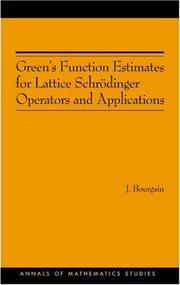
ISBN: 0691120978 1322075719 1400837146 0691120986 9780691120980 9781400837144 9780691120973 9781322075716 Year: 2005 Publisher: Princeton, New Jersey : Princeton University Press,
Abstract | Keywords | Export | Availability | Bookmark
 Loading...
Loading...Choose an application
- Reference Manager
- EndNote
- RefWorks (Direct export to RefWorks)
This book presents an overview of recent developments in the area of localization for quasi-periodic lattice Schrödinger operators and the theory of quasi-periodicity in Hamiltonian evolution equations. The physical motivation of these models extends back to the works of Rudolph Peierls and Douglas R. Hofstadter, and the models themselves have been a focus of mathematical research for two decades. Jean Bourgain here sets forth the results and techniques that have been discovered in the last few years. He puts special emphasis on so-called "non-perturbative" methods and the important role of subharmonic function theory and semi-algebraic set methods. He describes various applications to the theory of differential equations and dynamical systems, in particular to the quantum kicked rotor and KAM theory for nonlinear Hamiltonian evolution equations. Intended primarily for graduate students and researchers in the general area of dynamical systems and mathematical physics, the book provides a coherent account of a large body of work that is presently scattered in the literature. It does so in a refreshingly contained manner that seeks to convey the present technological "state of the art."
Schrödinger operator. --- Green's functions. --- Hamiltonian systems. --- Evolution equations. --- Evolutionary equations --- Equations, Evolution --- Equations of evolution --- Hamiltonian dynamical systems --- Systems, Hamiltonian --- Functions, Green's --- Functions, Induction --- Functions, Source --- Green functions --- Induction functions --- Source functions --- Operator, Schrödinger --- Differential equations --- Differentiable dynamical systems --- Potential theory (Mathematics) --- Differential operators --- Quantum theory --- Schrödinger equation --- Almost Mathieu operator. --- Analytic function. --- Anderson localization. --- Betti number. --- Cartan's theorem. --- Chaos theory. --- Density of states. --- Dimension (vector space). --- Diophantine equation. --- Dynamical system. --- Equation. --- Existential quantification. --- Fundamental matrix (linear differential equation). --- Green's function. --- Hamiltonian system. --- Hermitian adjoint. --- Infimum and supremum. --- Iterative method. --- Jacobi operator. --- Linear equation. --- Linear map. --- Linearization. --- Monodromy matrix. --- Non-perturbative. --- Nonlinear system. --- Normal mode. --- Parameter space. --- Parameter. --- Parametrization. --- Partial differential equation. --- Periodic boundary conditions. --- Phase space. --- Phase transition. --- Polynomial. --- Renormalization. --- Self-adjoint. --- Semialgebraic set. --- Special case. --- Statistical significance. --- Subharmonic function. --- Summation. --- Theorem. --- Theory. --- Transfer matrix. --- Transversality (mathematics). --- Trigonometric functions. --- Trigonometric polynomial. --- Uniformization theorem.
Book
ISBN: 3039212001 3039211994 Year: 2019 Publisher: MDPI - Multidisciplinary Digital Publishing Institute
Abstract | Keywords | Export | Availability | Bookmark
 Loading...
Loading...Choose an application
- Reference Manager
- EndNote
- RefWorks (Direct export to RefWorks)
Ultrasound medical imaging stands out among the other diagnostic imaging modalities for its patient-friendliness, high temporal resolution, low cost, and absence of ionizing radiation. On the other hand, it may still suffer from limited detail level, low signal-to-noise ratio, and narrow field-of-view. In the last decade, new beamforming and image reconstruction techniques have emerged which aim at improving resolution, contrast, and clutter suppression, especially in difficult-to-image patients. Nevertheless, achieving a higher image quality is of the utmost importance in diagnostic ultrasound medical imaging, and further developments are still indispensable. From this point of view, a crucial role can be played by novel beamforming techniques as well as by non-conventional image formation techniques (e.g., advanced transmission strategies, and compounding, coded, and harmonic imaging). This Special Issue includes novel contributions on both ultrasound beamforming and image formation techniques, particularly addressed at improving B-mode image quality and related diagnostic content. This indeed represents a hot topic in the ultrasound imaging community, and further active research in this field is expected, where many challenges still persist.
n/a --- signal-to-noise ratio (SNR) --- multi-perspective ultrasound imaging --- dictionary learning --- common carotid artery --- spatial resolution --- contrast enhancement --- sparse representation --- PMUT linear array --- K-singular value decomposition --- time resolution --- cardiac imaging --- coded excitation --- plane wave --- beam pattern --- grating lobe suppression --- spatial coherence --- subcutaneous fat layer --- cylindrical scanning --- parallel beam forming --- microbubble --- MR-visible fiducial marker --- ultrasonic imaging --- speckle reduction --- multi-line transmission --- MRI --- adaptive beamforming --- super-resolution --- filtered-delay multiply and sum beamforming --- B-mode imaging --- medical ultrasound --- intima-media complex longitudinal motion --- synthetic aperture --- quantitative parametrization --- arterial wall motion --- pth root --- beam forming --- medical image processing --- crosstalk artifacts --- ultrasound imaging --- diverging wave --- 1-3 piezocomposite material --- dynamic focusing --- multi-line acquisition --- image reconstruction --- plane wave imaging --- ultrasound --- multi-line transmit --- reconstruction --- thyroid imaging --- beamforming
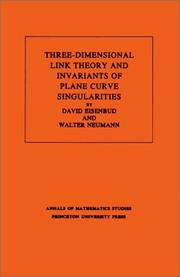
ISBN: 0691083819 0691083800 1400881927 9780691083810 9780691083803 Year: 1985 Volume: 110 Publisher: Princeton (N.J.): Princeton university press,
Abstract | Keywords | Export | Availability | Bookmark
 Loading...
Loading...Choose an application
- Reference Manager
- EndNote
- RefWorks (Direct export to RefWorks)
This book gives a new foundation for the theory of links in 3-space modeled on the modern developmentby Jaco, Shalen, Johannson, Thurston et al. of the theory of 3-manifolds. The basic construction is a method of obtaining any link by "splicing" links of the simplest kinds, namely those whose exteriors are Seifert fibered or hyperbolic. This approach to link theory is particularly attractive since most invariants of links are additive under splicing.Specially distinguished from this viewpoint is the class of links, none of whose splice components is hyperbolic. It includes all links constructed by cabling and connected sums, in particular all links of singularities of complex plane curves. One of the main contributions of this monograph is the calculation of invariants of these classes of links, such as the Alexander polynomials, monodromy, and Seifert forms.
Algebraic geometry --- Differential geometry. Global analysis --- Link theory. --- Curves, Plane. --- SINGULARITIES (Mathematics) --- Curves, Plane --- Invariants --- Link theory --- Singularities (Mathematics) --- Geometry, Algebraic --- Low-dimensional topology --- Piecewise linear topology --- Higher plane curves --- Plane curves --- Invariants. --- 3-sphere. --- Alexander Grothendieck. --- Alexander polynomial. --- Algebraic curve. --- Algebraic equation. --- Algebraic geometry. --- Algebraic surface. --- Algorithm. --- Ambient space. --- Analytic function. --- Approximation. --- Big O notation. --- Call graph. --- Cartesian coordinate system. --- Characteristic polynomial. --- Closed-form expression. --- Cohomology. --- Computation. --- Conjecture. --- Connected sum. --- Contradiction. --- Coprime integers. --- Corollary. --- Curve. --- Cyclic group. --- Determinant. --- Diagram (category theory). --- Diffeomorphism. --- Dimension. --- Disjoint union. --- Eigenvalues and eigenvectors. --- Equation. --- Equivalence class. --- Euler number. --- Existential quantification. --- Exterior (topology). --- Fiber bundle. --- Fibration. --- Foliation. --- Fundamental group. --- Geometry. --- Graph (discrete mathematics). --- Ground field. --- Homeomorphism. --- Homology sphere. --- Identity matrix. --- Integer matrix. --- Intersection form (4-manifold). --- Isolated point. --- Isolated singularity. --- Jordan normal form. --- Knot theory. --- Mathematical induction. --- Monodromy matrix. --- Monodromy. --- N-sphere. --- Natural transformation. --- Newton polygon. --- Newton's method. --- Normal (geometry). --- Notation. --- Pairwise. --- Parametrization. --- Plane curve. --- Polynomial. --- Power series. --- Projective plane. --- Puiseux series. --- Quantity. --- Rational function. --- Resolution of singularities. --- Riemann sphere. --- Riemann surface. --- Root of unity. --- Scientific notation. --- Seifert surface. --- Set (mathematics). --- Sign (mathematics). --- Solid torus. --- Special case. --- Stereographic projection. --- Submanifold. --- Summation. --- Theorem. --- Three-dimensional space (mathematics). --- Topology. --- Torus knot. --- Torus. --- Tubular neighborhood. --- Unit circle. --- Unit vector. --- Unknot. --- Variable (mathematics).
Book
ISBN: 0691080291 1322884943 069164554X 1400869293 9781400869299 9780691618548 0691618542 Year: 2015 Publisher: Princeton, NJ : Princeton University Press,
Abstract | Keywords | Export | Availability | Bookmark
 Loading...
Loading...Choose an application
- Reference Manager
- EndNote
- RefWorks (Direct export to RefWorks)
This book is a sequel to Lectures on Complex Analytic Varieties: The Local Paranwtrization Theorem (Mathematical Notes 10, 1970). Its unifying theme is the study of local properties of finite analytic mappings between complex analytic varieties; these mappings are those in several dimensions that most closely resemble general complex analytic mappings in one complex dimension. The purpose of this volume is rather to clarify some algebraic aspects of the local study of complex analytic varieties than merely to examine finite analytic mappings for their own sake.Originally published in 1970.The Princeton Legacy Library uses the latest print-on-demand technology to again make available previously out-of-print books from the distinguished backlist of Princeton University Press. These editions preserve the original texts of these important books while presenting them in durable paperback and hardcover editions. The goal of the Princeton Legacy Library is to vastly increase access to the rich scholarly heritage found in the thousands of books published by Princeton University Press since its founding in 1905.
Complex analysis --- Analytic spaces --- Mathematics --- Physical Sciences & Mathematics --- Calculus --- Spaces, Analytic --- Analytic functions --- Functions of several complex variables --- Algebra homomorphism. --- Algebraic curve. --- Algebraic extension. --- Algebraic surface. --- Algebraic variety. --- Analytic continuation. --- Analytic function. --- Associated prime. --- Atlas (topology). --- Automorphism. --- Bernhard Riemann. --- Big O notation. --- Branch point. --- Change of variables. --- Characterization (mathematics). --- Codimension. --- Coefficient. --- Cohomology. --- Complete intersection. --- Complex analysis. --- Complex conjugate. --- Complex dimension. --- Complex number. --- Connected component (graph theory). --- Corollary. --- Critical point (mathematics). --- Diagram (category theory). --- Dimension (vector space). --- Dimension. --- Disjoint union. --- Divisor. --- Equation. --- Equivalence class. --- Exact sequence. --- Existential quantification. --- Finitely generated module. --- Geometry. --- Hamiltonian mechanics. --- Holomorphic function. --- Homeomorphism. --- Homological dimension. --- Homomorphism. --- Hypersurface. --- Ideal (ring theory). --- Identity element. --- Induced homomorphism. --- Inequality (mathematics). --- Injective function. --- Integral domain. --- Invertible matrix. --- Irreducible component. --- Isolated singularity. --- Isomorphism class. --- Jacobian matrix and determinant. --- Linear map. --- Linear subspace. --- Local ring. --- Mathematical induction. --- Mathematics. --- Maximal element. --- Maximal ideal. --- Meromorphic function. --- Modular arithmetic. --- Module (mathematics). --- Module homomorphism. --- Monic polynomial. --- Monomial. --- Neighbourhood (mathematics). --- Noetherian. --- Open set. --- Parametric equation. --- Parametrization. --- Permutation. --- Polynomial ring. --- Polynomial. --- Power series. --- Quadratic form. --- Quotient module. --- Regular local ring. --- Removable singularity. --- Ring (mathematics). --- Ring homomorphism. --- Row and column vectors. --- Scalar multiplication. --- Scientific notation. --- Several complex variables. --- Sheaf (mathematics). --- Special case. --- Subalgebra. --- Submanifold. --- Subset. --- Summation. --- Surjective function. --- Taylor series. --- Theorem. --- Three-dimensional space (mathematics). --- Topological space. --- Vector space. --- Weierstrass preparation theorem. --- Zero divisor. --- Fonctions de plusieurs variables complexes --- Variétés complexes

ISBN: 0691085773 1306986230 0691602891 0691632340 1400861063 9780691085777 Year: 1990 Volume: 39 Publisher: Princeton (N.J.): Princeton university press,
Abstract | Keywords | Export | Availability | Bookmark
 Loading...
Loading...Choose an application
- Reference Manager
- EndNote
- RefWorks (Direct export to RefWorks)
One of the great achievements of contemporary mathematics is the new understanding of four dimensions. Michael Freedman and Frank Quinn have been the principals in the geometric and topological development of this subject, proving the Poincar and Annulus conjectures respectively. Recognition for this work includes the award of the Fields Medal of the International Congress of Mathematicians to Freedman in 1986. In Topology of 4-Manifolds these authors have collaborated to give a complete and accessible account of the current state of knowledge in this field. The basic material has been considerably simplified from the original publications, and should be accessible to most graduate students. The advanced material goes well beyond the literature; nearly one-third of the book is new. This work is indispensable for any topologist whose work includes four dimensions. It is a valuable reference for geometers and physicists who need an awareness of the topological side of the field.Originally published in 1990.The Princeton Legacy Library uses the latest print-on-demand technology to again make available previously out-of-print books from the distinguished backlist of Princeton University Press. These editions preserve the original texts of these important books while presenting them in durable paperback and hardcover editions. The goal of the Princeton Legacy Library is to vastly increase access to the rich scholarly heritage found in the thousands of books published by Princeton University Press since its founding in 1905.
Differential topology --- Four-manifolds (Topology) --- Trois-variétés (Topologie) --- Vier-menigvuldigheden (Topologie) --- 4-dimensional manifolds (Topology) --- 4-manifolds (Topology) --- Four dimensional manifolds (Topology) --- Manifolds, Four dimensional --- Low-dimensional topology --- Topological manifolds --- 4-manifold. --- Ambient isotopy. --- Annulus theorem. --- Automorphism. --- Baire category theorem. --- Bilinear form. --- Boundary (topology). --- CW complex. --- Category of manifolds. --- Central series. --- Characterization (mathematics). --- Cohomology. --- Commutative diagram. --- Commutative property. --- Commutator subgroup. --- Compactification (mathematics). --- Conformal geometry. --- Connected sum. --- Connectivity (graph theory). --- Cyclic group. --- Diagram (category theory). --- Diameter. --- Diffeomorphism. --- Differentiable manifold. --- Differential geometry. --- Dimension. --- Disk (mathematics). --- Duality (mathematics). --- Eigenvalues and eigenvectors. --- Embedding problem. --- Embedding. --- Equivariant map. --- Fiber bundle. --- Four-dimensional space. --- Fundamental group. --- General position. --- Geometry. --- H-cobordism. --- Handlebody. --- Hauptvermutung. --- Homeomorphism. --- Homology (mathematics). --- Homology sphere. --- Homomorphism. --- Homotopy group. --- Homotopy sphere. --- Homotopy. --- Hurewicz theorem. --- Hyperbolic geometry. --- Hyperbolic group. --- Hyperbolic manifold. --- Identity matrix. --- Intermediate value theorem. --- Intersection (set theory). --- Intersection curve. --- Intersection form (4-manifold). --- Intersection number (graph theory). --- Intersection number. --- J-homomorphism. --- Knot theory. --- Lefschetz duality. --- Line–line intersection. --- Manifold. --- Mapping cylinder. --- Mathematical induction. --- Metric space. --- Metrization theorem. --- Module (mathematics). --- Normal bundle. --- Parametrization. --- Parity (mathematics). --- Product topology. --- Pullback (differential geometry). --- Regular homotopy. --- Ring homomorphism. --- Rotation number. --- Seifert–van Kampen theorem. --- Sesquilinear form. --- Set (mathematics). --- Simply connected space. --- Smooth structure. --- Special case. --- Spin structure. --- Submanifold. --- Subset. --- Support (mathematics). --- Tangent bundle. --- Tangent space. --- Tensor product. --- Theorem. --- Topological category. --- Topological manifold. --- Transversal (geometry). --- Transversality (mathematics). --- Transversality theorem. --- Uniqueness theorem. --- Unit disk. --- Vector bundle. --- Whitehead torsion. --- Whitney disk.

ISBN: 0691112983 1400884330 9781400884339 9780691112985 Year: 2016 Publisher: Princeton, NJ : Princeton University Press,
Abstract | Keywords | Export | Availability | Bookmark
 Loading...
Loading...Choose an application
- Reference Manager
- EndNote
- RefWorks (Direct export to RefWorks)
Rabinowitz's classical global bifurcation theory, which concerns the study in-the-large of parameter-dependent families of nonlinear equations, uses topological methods that address the problem of continuous parameter dependence of solutions by showing that there are connected sets of solutions of global extent. Even when the operators are infinitely differentiable in all the variables and parameters, connectedness here cannot in general be replaced by path-connectedness. However, in the context of real-analyticity there is an alternative theory of global bifurcation due to Dancer, which offers a much stronger notion of parameter dependence. This book aims to develop from first principles Dancer's global bifurcation theory for one-parameter families of real-analytic operators in Banach spaces. It shows that there are globally defined continuous and locally real-analytic curves of solutions. In particular, in the real-analytic setting, local analysis can lead to global consequences--for example, as explained in detail here, those resulting from bifurcation from a simple eigenvalue. Included are accounts of analyticity and implicit function theorems in Banach spaces, classical results from the theory of finite-dimensional analytic varieties, and the links between these two and global existence theory. Laying the foundations for more extensive studies of real-analyticity in infinite-dimensional problems and illustrating the theory with examples, Analytic Theory of Global Bifurcation is intended for graduate students and researchers in pure and applied analysis.
Differential geometry. Global analysis --- Bifurcation theory. --- Differential equations, Nonlinear --- Stability --- Numerical solutions --- Addition. --- Algebraic equation. --- Analytic function. --- Analytic manifold. --- Atmospheric pressure. --- Banach space. --- Bernhard Riemann. --- Bifurcation diagram. --- Boundary value problem. --- Bounded operator. --- Bounded set (topological vector space). --- Boundedness. --- Canonical form. --- Cartesian coordinate system. --- Codimension. --- Compact operator. --- Complex analysis. --- Complex conjugate. --- Complex number. --- Connected space. --- Coordinate system. --- Corollary. --- Curvature. --- Derivative. --- Diagram (category theory). --- Differentiable function. --- Differentiable manifold. --- Dimension (vector space). --- Dimension. --- Direct sum. --- Eigenvalues and eigenvectors. --- Elliptic integral. --- Embedding. --- Equation. --- Euclidean division. --- Euler equations (fluid dynamics). --- Existential quantification. --- First principle. --- Fredholm operator. --- Froude number. --- Functional analysis. --- Hilbert space. --- Homeomorphism. --- Implicit function theorem. --- Integer. --- Linear algebra. --- Linear function. --- Linear independence. --- Linear map. --- Linear programming. --- Linear space (geometry). --- Linear subspace. --- Linearity. --- Linearization. --- Metric space. --- Morse theory. --- Multilinear form. --- N0. --- Natural number. --- Neumann series. --- Nonlinear functional analysis. --- Nonlinear system. --- Numerical analysis. --- Open mapping theorem (complex analysis). --- Operator (physics). --- Ordinary differential equation. --- Parameter. --- Parametrization. --- Partial differential equation. --- Permutation group. --- Permutation. --- Polynomial. --- Power series. --- Prime number. --- Proportionality (mathematics). --- Pseudo-differential operator. --- Puiseux series. --- Quantity. --- Real number. --- Resultant. --- Singularity theory. --- Skew-symmetric matrix. --- Smoothness. --- Solution set. --- Special case. --- Standard basis. --- Sturm–Liouville theory. --- Subset. --- Symmetric bilinear form. --- Symmetric group. --- Taylor series. --- Taylor's theorem. --- Theorem. --- Total derivative. --- Two-dimensional space. --- Union (set theory). --- Variable (mathematics). --- Vector space. --- Zero of a function.
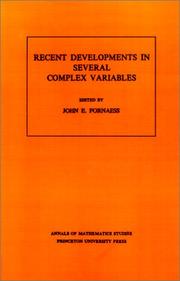
ISBN: 0691082855 0691082812 1400881544 Year: 1981 Publisher: Princeton (N.J.) : Princeton university press,
Abstract | Keywords | Export | Availability | Bookmark
 Loading...
Loading...Choose an application
- Reference Manager
- EndNote
- RefWorks (Direct export to RefWorks)
The description for this book, Recent Developments in Several Complex Variables. (AM-100), Volume 100, will be forthcoming.
Complex analysis --- Functions of several complex variables. --- Complex variables --- Several complex variables, Functions of --- Functions of complex variables --- Analytic continuation. --- Analytic function. --- Analytic set. --- Analytic space. --- Asymptotic expansion. --- Automorphic function. --- Axiom. --- Base change. --- Bergman metric. --- Betti number. --- Big O notation. --- Bilinear form. --- Boundary value problem. --- CR manifold. --- Canonical bundle. --- Cauchy problem. --- Cauchy–Riemann equations. --- Characteristic variety. --- Codimension. --- Coefficient. --- Cohomology ring. --- Cohomology. --- Commutative property. --- Commutator. --- Compactification (mathematics). --- Complete intersection. --- Complete metric space. --- Complex dimension. --- Complex manifold. --- Complex number. --- Complex plane. --- Complex projective space. --- Complex space. --- Complex-analytic variety. --- Degeneracy (mathematics). --- Dense set. --- Determinant. --- Diffeomorphism. --- Differentiable function. --- Dimension (vector space). --- Dimension. --- Eigenvalues and eigenvectors. --- Embedding. --- Existential quantification. --- Explicit formulae (L-function). --- Fermat curve. --- Fiber bundle. --- Fundamental solution. --- Gorenstein ring. --- Hartogs' extension theorem. --- Hilbert space. --- Hilbert transform. --- Holomorphic function. --- Homotopy. --- Hyperfunction. --- Hypersurface. --- Hypoelliptic operator. --- Interpolation theorem. --- Irreducible component. --- Isometry. --- Linear map. --- Manifold. --- Maximal ideal. --- Monic polynomial. --- Monotonic function. --- Multiple integral. --- Nilpotent Lie algebra. --- Norm (mathematics). --- Open set. --- Orthogonal group. --- Parametrization. --- Permutation. --- Plurisubharmonic function. --- Polynomial. --- Principal bundle. --- Principal part. --- Principal value. --- Projection (linear algebra). --- Projective line. --- Proper map. --- Quadratic function. --- Real projective space. --- Resolution of singularities. --- Riemann surface. --- Riemannian manifold. --- Sectional curvature. --- Sheaf cohomology. --- Special case. --- Submanifold. --- Subset. --- Symplectic vector space. --- Tangent space. --- Theorem. --- Topology. --- Uniqueness theorem. --- Unit disk. --- Unit sphere. --- Variable (mathematics). --- Vector bundle. --- Vector field. --- Fonctions de variables complexes --- Colloque
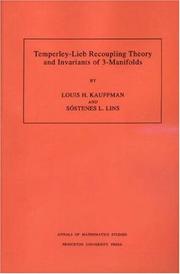
ISBN: 0691036411 0691036403 1400882532 9780691036403 9780691036410 Year: 1994 Volume: 134 Publisher: Princeton (N.J.): Princeton university press,
Abstract | Keywords | Export | Availability | Bookmark
 Loading...
Loading...Choose an application
- Reference Manager
- EndNote
- RefWorks (Direct export to RefWorks)
This book offers a self-contained account of the 3-manifold invariants arising from the original Jones polynomial. These are the Witten-Reshetikhin-Turaev and the Turaev-Viro invariants. Starting from the Kauffman bracket model for the Jones polynomial and the diagrammatic Temperley-Lieb algebra, higher-order polynomial invariants of links are constructed and combined to form the 3-manifold invariants. The methods in this book are based on a recoupling theory for the Temperley-Lieb algebra. This recoupling theory is a q-deformation of the SU(2) spin networks of Roger Penrose. The recoupling theory is developed in a purely combinatorial and elementary manner. Calculations are based on a reformulation of the Kirillov-Reshetikhin shadow world, leading to expressions for all the invariants in terms of state summations on 2-cell complexes. Extensive tables of the invariants are included. Manifolds in these tables are recognized by surgery presentations and by means of 3-gems (graph encoded 3-manifolds) in an approach pioneered by Sostenes Lins. The appendices include information about gems, examples of distinct manifolds with the same invariants, and applications to the Turaev-Viro invariant and to the Crane-Yetter invariant of 4-manifolds.
Drie-menigvuldigheden (Topologie) --- Knopentheorie --- Knot theory --- Noeuds [Theorie des ] --- Three-manifolds (Topology) --- Trois-variétés (Topologie) --- Knot theory. --- Algebraic topology --- Invariants --- Mathematics --- Invariants (Mathematics) --- Invariants. --- 3-manifolds (Topology) --- Manifolds, Three dimensional (Topology) --- Three-dimensional manifolds (Topology) --- Low-dimensional topology --- Topological manifolds --- Knots (Topology) --- 3-manifold. --- Addition. --- Algorithm. --- Ambient isotopy. --- Axiom. --- Backslash. --- Barycentric subdivision. --- Bijection. --- Bipartite graph. --- Borromean rings. --- Boundary parallel. --- Bracket polynomial. --- Calculation. --- Canonical form. --- Cartesian product. --- Cobordism. --- Coefficient. --- Combination. --- Commutator. --- Complex conjugate. --- Computation. --- Connected component (graph theory). --- Connected sum. --- Cubic graph. --- Diagram (category theory). --- Dimension. --- Disjoint sets. --- Disjoint union. --- Elaboration. --- Embedding. --- Equation. --- Equivalence class. --- Explicit formula. --- Explicit formulae (L-function). --- Factorial. --- Fundamental group. --- Graph (discrete mathematics). --- Graph embedding. --- Handlebody. --- Homeomorphism. --- Homology (mathematics). --- Identity element. --- Intersection form (4-manifold). --- Inverse function. --- Jones polynomial. --- Kirby calculus. --- Line segment. --- Linear independence. --- Matching (graph theory). --- Mathematical physics. --- Mathematical proof. --- Mathematics. --- Maxima and minima. --- Monograph. --- Natural number. --- Network theory. --- Notation. --- Numerical analysis. --- Orientability. --- Orthogonality. --- Pairing. --- Pairwise. --- Parametrization. --- Parity (mathematics). --- Partition function (mathematics). --- Permutation. --- Poincaré conjecture. --- Polyhedron. --- Quantum group. --- Quantum invariant. --- Recoupling. --- Recursion. --- Reidemeister move. --- Result. --- Roger Penrose. --- Root of unity. --- Scientific notation. --- Sequence. --- Significant figures. --- Simultaneous equations. --- Smoothing. --- Special case. --- Sphere. --- Spin network. --- Summation. --- Symmetric group. --- Tetrahedron. --- The Geometry Center. --- Theorem. --- Theory. --- Three-dimensional space (mathematics). --- Time complexity. --- Tubular neighborhood. --- Two-dimensional space. --- Vector field. --- Vector space. --- Vertex (graph theory). --- Winding number. --- Writhe.
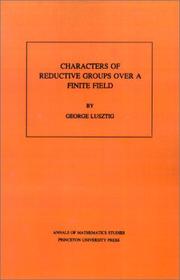
ISBN: 0691083509 0691083517 1400881773 9780691083513 9780691083506 Year: 1984 Volume: 107 Publisher: Princeton (N.J.): Princeton university press,
Abstract | Keywords | Export | Availability | Bookmark
 Loading...
Loading...Choose an application
- Reference Manager
- EndNote
- RefWorks (Direct export to RefWorks)
This book presents a classification of all (complex)irreducible representations of a reductive group withconnected centre, over a finite field. To achieve this,the author uses etale intersection cohomology, anddetailed information on representations of Weylgroups.
512 --- Characters of groups --- Finite fields (Algebra) --- Finite groups --- Groups, Finite --- Group theory --- Modules (Algebra) --- Modular fields (Algebra) --- Algebra, Abstract --- Algebraic fields --- Galois theory --- Characters, Group --- Group characters --- Groups, Characters of --- Representations of groups --- Rings (Algebra) --- Algebra --- 512 Algebra --- Finite groups. --- Characters of groups. --- Addition. --- Algebra representation. --- Algebraic closure. --- Algebraic group. --- Algebraic variety. --- Algebraically closed field. --- Bijection. --- Borel subgroup. --- Cartan subalgebra. --- Character table. --- Character theory. --- Characteristic function (probability theory). --- Characteristic polynomial. --- Class function (algebra). --- Classical group. --- Coefficient. --- Cohomology with compact support. --- Cohomology. --- Combination. --- Complex number. --- Computation. --- Conjugacy class. --- Connected component (graph theory). --- Coxeter group. --- Cyclic group. --- Cyclotomic polynomial. --- David Kazhdan. --- Dense set. --- Derived category. --- Diagram (category theory). --- Dimension. --- Direct sum. --- Disjoint sets. --- Disjoint union. --- E6 (mathematics). --- Eigenvalues and eigenvectors. --- Endomorphism. --- Equivalence class. --- Equivalence relation. --- Existential quantification. --- Explicit formula. --- Explicit formulae (L-function). --- Fiber bundle. --- Finite field. --- Finite group. --- Fourier transform. --- Green's function. --- Group (mathematics). --- Group action. --- Group representation. --- Harish-Chandra. --- Hecke algebra. --- Identity element. --- Integer. --- Irreducible representation. --- Isomorphism class. --- Jordan decomposition. --- Line bundle. --- Linear combination. --- Local system. --- Mathematical induction. --- Maximal torus. --- Module (mathematics). --- Monodromy. --- Morphism. --- Orthonormal basis. --- P-adic number. --- Parametrization. --- Parity (mathematics). --- Partially ordered set. --- Perverse sheaf. --- Pointwise. --- Polynomial. --- Quantity. --- Rational point. --- Reductive group. --- Ree group. --- Schubert variety. --- Scientific notation. --- Semisimple Lie algebra. --- Sheaf (mathematics). --- Simple group. --- Simple module. --- Special case. --- Standard basis. --- Subset. --- Subtraction. --- Summation. --- Surjective function. --- Symmetric group. --- Tensor product. --- Theorem. --- Two-dimensional space. --- Unipotent representation. --- Vector bundle. --- Vector space. --- Verma module. --- Weil conjecture. --- Weyl group. --- Zariski topology.
| Listing 1 - 10 of 19 | << page >> |
Sort by
|

 Search
Search Feedback
Feedback About UniCat
About UniCat  Help
Help News
News